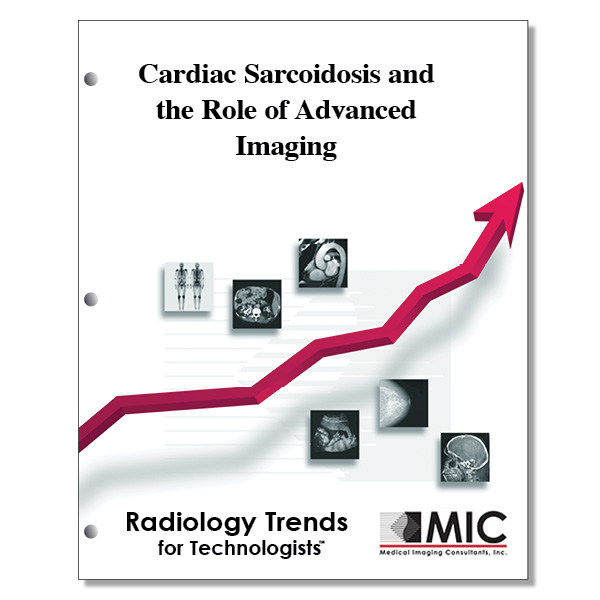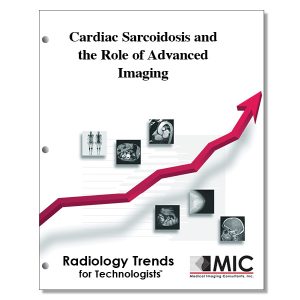

Cardiac Sarcoidosis and the Role of Advanced Imaging
A review of important theoretic and practical aspects of using cardiac imaging tools in the evaluation of patients with suspected or established cardiac sarcoidosis.
Course ID: Q00590 Category: Radiology Trends for Technologists Modalities: MRI, Nuclear Cardiology, Nuclear Medicine, PET, Sonography2.5 |
Satisfaction Guarantee |
$29.00
- Targeted CE
- Outline
- Objectives
Targeted CE per ARRT’s Discipline, Category, and Subcategory classification for enrollments starting after January 27, 2023:
[Note: Discipline-specific Targeted CE credits may be less than the total Category A credits approved for this course.]
Cardiac-Interventional Radiography: 1.25
Procedures: 1.25
Diagnostic and Electrophysiology Procedures: 1.25
Nuclear Medicine Technology: 1.25
Procedures: 1.25
Cardiac Procedures: 1.25
Registered Radiologist Assistant: 1.25
Procedures: 1.25
Thoracic Section: 1.25
Outline
- Introduction
- Pathology Relevant for Cardiac Imaging
- Diagnosis
- Echocardiography
- SPECT
- 18F-FDG PET
- CMR
- Therapeutic and Prognostic Considerations of Cardiac PET and CMR
- 18F-FDG PET
- CMR
- 18F-FDG PET Versus CMR
- Hybrid CMR/PET
- Clinical use of Advanced Cardiac Imaging in CS
- Diagnostic Tool in Patients with Established Extracardiac Sarcoidosis
- Diagnostic Tool in Patients Without Established Extracardiac Sarcoidosis
- Therapeutic Response Monitoring in Patients with Established Inflammatory CS
- Prognostication in Patients with Established CS Considered for Device Therapy
- Conclusion
Objectives
Upon completion of this course, students will:
- describe the reasons associated with the importance of effectively diagnosing CS
- list the patient population who should be considered for CS evaluation
- identify the organization that provides current criteria that are key for a CS diagnosis
- understand the various histological stages associated with CS
- recognize which imaging modality is best suited for identifying edema and inflammation
- identify which left ventricular cardiac walls are commonly affected by CS
- identify which imaging modality is best at evaluating basal septal thinning
- isolate which initial imaging modality is utilized in patients with suspected CS
- explain what speckle tracking echocardiography can offer in patients with possible CS
- describe the physiology behind “reverse distribution” with SPECT imaging
- differentiate between PET and SPECT cardiac perfusion as it relates to spatial resolution
- describe why PET inflammatory imaging is combined with another imaging procedure to aid in the diagnosis of CS
- explain why 18F-FDG PET can be non-specific for CS
- list advantages and disadvantages as they relate to 18F-FDG PET imaging
- understand which imaging modality is affected by diet, fasting and heparin intervention
- describe how 68GA-DOTANOC PET imaging can aid in the diagnosis of CS
- know what role CMR plays in diagnosing CS
- list the common cardiac ventricular sarcoidosis sites for LGE
- know the annual rate of ventricular tachycardia and death when myocardial perfusion defects and abnormal 18F-FDG uptake are discovered
- identify the preferred imaging procedure for evaluating immunosuppressive therapy response
- isolate which imaging procedure is thought to be a strong prognosticator for future cardiac events in patients with CS
- explain the clinical implications when LGE is observed
- explain what is meant by a “gold standard” when it comes to diagnosing CS
- label the imaging modality that is thought to have higher specificity
- explain how the study by Ju Lee related CMR with LGE to 18F-FDG PET
- list and understand the various imaging patterns associated with CMR/PET imaging
- identify what image pattern may relate to a false positive on CMR/PET imaging
- describe the relationship between LGE and 18F-FDG uptake based on the study conducted by Vita et al
- describe the parameters and findings listed to detect active CS in the study by Dweck et al
- list the findings on CMR/PET hybrid imaging that provide complementary value in patients with suspected CS
- list the suggested initial screening approaches for patients positive for extracardiac sarcoidosis and suspected of CS
- identify which initial imaging approach is best suited for evaluating CS in patients with established extracardiac sarcoidosis
- name the imaging modality that can occasionally be used when CMR is negative
- explain what clinical context should be considered to diagnose CS in patients without established extracardiac sarcoidosis
- identify what general consensus has been established for identifying CS in patients without known extra cardiac sarcoidosis
- explain what imaging procedures could be utilized for evaluating possible CS in the absence of extracardiac sarcoidosis
- list the caveats associated with cardiac imaging findings in patients without extracardiac sarcoidosis
- identify which imaging procedure has gained value with initial therapy planning
- list the criteria needed for an implantable cardioverter-defibrillator device
- identify the challenges and recommendations needed for diagnosing CS
